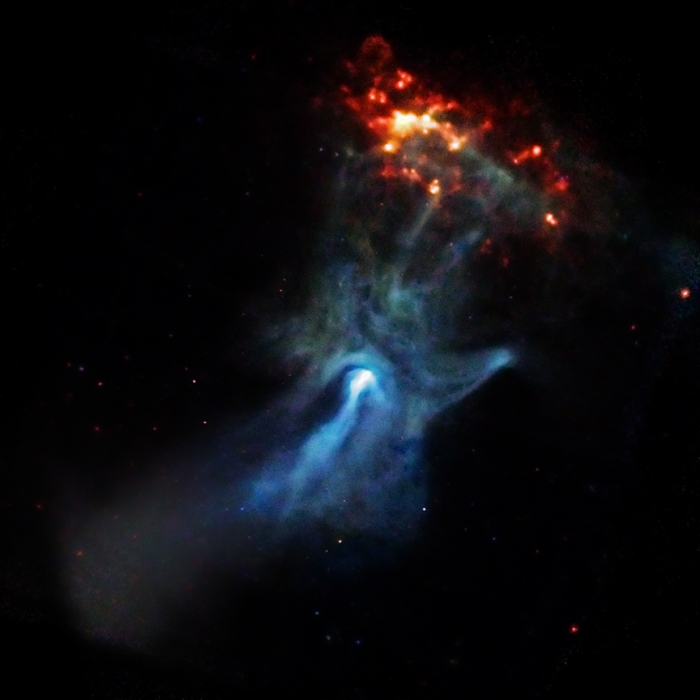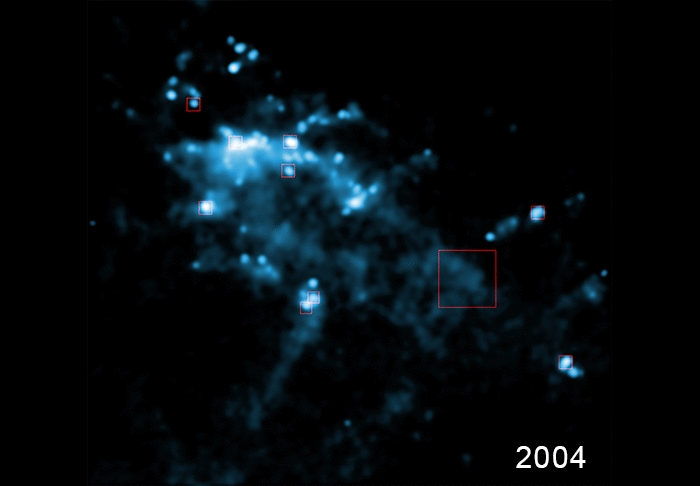A ghostly "hand" reaching through the cosmos has just given us new insight into the violent deaths of massive stars.
The spectacular structure is the ejecta from a core-collapse supernova, and, by taking images of it over a 14-year span, astronomers have been able to observe as it blasts into space at around 4,000 kilometers (2,485 miles) per second.
At the very tips of the "fingers", the supernova remnant and blast wave - named MSH 15-52 - is punching into a cloud of gas called RCW 89, generating shocks and knots in the material, and causing the expanding supernova to decelerate.
MSH 15-52 is located 17,000 light-years away from Earth, and it seems to be one of the youngest known supernova remnants in the Milky Way. Light from the stellar explosion reached Earth approximately 1,700 years ago, as the progenitor star ran out of fuel to support fusion, exploding its outer material into space, and collapsing its core.
 (NASA/CXC/SAO/P.Slane, et al.)
(NASA/CXC/SAO/P.Slane, et al.)
That collapsed core turned into a type of "dead" star called a pulsar, an extremely dense object with neutrons packed so tightly that they take on some of the properties of an atomic nucleus, pulsing light from its poles as it rotates at high speed.
This rotation also helps shape the X-ray nebula of ejected stellar material expanding into space.
Exactly how fast it is expanding has been detailed in a new study, which uses images from 2004, 2008, and 2017-2018 to observe changes in RCW 89 as the supernova remnant plunges into it.
By calculating the distance traveled by these features over time, we have a better understanding of the velocity of the shock wave, and knots of ejected stellar material in MSH 15-52. You can see this in the image below.
 (NASA/SAO/NCSU/Borkowski et al.)
(NASA/SAO/NCSU/Borkowski et al.)
The blast wave, located near one of the fingertips of the hand, is a feature where MSH 15-52 meets RCW 89 that is moving at a velocity of 4,000 kilometers per second, but some knots of material are moving even faster, at up to 5,000 km/s.
These knots are thought to be clumps of magnesium and neon that formed in the star, prior to supernova explosion, and they're moving at different speeds. Even the slowest seem insanely fast, around 1,000 km/s.
Even so, these features are slowing down as they interact with the material in RCW 89. The distance from the pulsar to RCW 89 is about 75 light-years; to bridge that distance, the required mean expansion velocity of the outer edge of MSH 15-52 is 13,000 km/s.
This means, the researchers have ascertained, that the material would have passed through a relatively low-density cavity or bubble in the gas around the exploded star before encountering RCW 89. This is consistent with the core-collapse supernova model.
As the precursor star reached the end of its main-sequence lifespan, a powerful stellar wind would have blown into the space around it, stripping the star of its hydrogen, and creating a giant cavity. Then, when the star's core finally collapsed in a supernova, the explosion ejected the remaining stellar material into this relatively empty region of space.
RCW 89 represents the wall of the cavity. When MSH 15-52 encountered this higher-density region, the collision caused a rapid deceleration.
Supernova ejecta at the higher velocity range has also been observed in the supernova remnant Cassiopeia A, located 11,000 light-years away. This is also thought to have been a core-collapse supernova, but we observed it much more recently - light from the explosion reached Earth a mere 350 years ago.
We don't really understand the origin of the fast-moving clumps in either supernova yet, but collecting more data, and studying such explosions at different timespans, will help astronomers painstakingly piece the puzzle together.
The research has been published in The Astrophysical Journal Letters.
#Space | https://sciencespies.com/space/you-can-finally-watch-the-blast-of-a-cosmic-supernova-with-your-own-eyes/
No comments:
Post a Comment